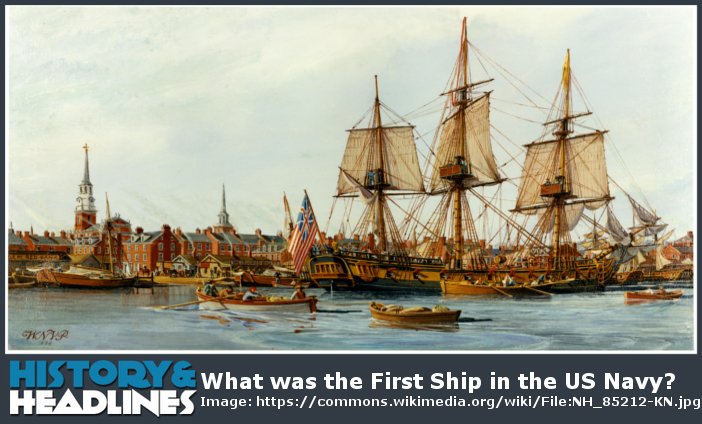A Brief History
On December 3, 1775, the Alfred, a merchant ship purchased by the Continental Congress was commissioned under Captain Dudley Saltonstall and became the first to fly what would become the American Flag. The US Navy marks October 13, 1775, as its birthday, the day when the Continental Congress passed the resolution that created the Continental Navy, the precursor to the United States Navy.
Digging Deeper
The Alfred was not the first ship purchased specifically for the Continental Navy, as that honor goes to the Cabot and the Andrew Doria (not to be confused with the doomed 20th Century ocean liner), but it was the Alfred to become the first commissioned vessel to fly our flag. In 1775, with the American Revolutionary War and ultimately the United States in its infancy, the building of purpose-built warships could not possibly take place fast enough to suit the needs of the Continental Congress and the legislatures of the various American colonies. Thus, it was necessary to convert merchant vessels to warships by arming them with cannon and making whatever modifications were needed to facilitate the bearing of arms.
The Alfred was a small ship by our modern standards, even tiny compared to ocean going modern naval vessels. Only 140 feet long and with a beam of 32 feet, Alfred displaced only 440 tons, though she was heavily armed for her size, boasting 20 “nine pounder” guns and 10 “six pounder” guns manned by a crew of 220 men. The ship started its life in 1774, built in Philadelphia and originally named the Black Prince in honor of the then heir to the English throne, Edward, the eldest son of King Edward III of England. (The namesake of the Black Prince died in 1776 at the age of 45, never ascending to the throne.) Not only was the ship named after a presumptive English monarch, the name Alfred came from the 9th century English monarch Alfred the Great. It seems somewhat ironic that the first ship of what became the United States Navy would be named after English kings!
Alfred was joined by other converted merchant ships, the Columbus, the Cabot, Andrew Doria and Providence, forming the first fleet of the American Navy. Esek Hopkins (1718-1802) was appointed “commodore” in charge of this little fleet and Alfred became his flagship. (Question: Have you ever heard of anyone else with the first name of “Esek?”) Hopkins remained Commander in Chief of the American Navy throughout the American Revolutionary War. Hopkins also has the distinction of having been appointed a Brigadier General of the Rhode Island Militia prior to his appointment as Commodore. His maritime background included sailing merchant cargoes and action as a privateer. So far 3 US Navy ships have been named in his honor.
The tiny Continental Navy was not really any sort of match for the British Navy, the most powerful navy in the world. The British could sail such powerful vessels as the HMS Victory, a “ship of the line” that boasted 104 guns and displaced 3500 tons, nearly 9 times the burthen of the Alfred. Among those 104 guns were 30 “thirty-two pounder” cannons, giant guns compared to those on the American ships.
The career of Alfred as an American naval vessel was not long. Unable to outrun pursuing British ships, she was captured in 1778 off the island of Barbados and converted to service for the British as HMS Alfred. Alfred became the property of the United Kingdom as a merchant vessel once again in 1802 (after Great Britain was reorganized in 1801), and was known to still be serving in 1789, though her ultimate fate is unknown.
As we have in the past, we take this opportunity to once again salute and honor the men and women of the US Navy, past and present!
Question for students (and subscribers): Have you or any of your relatives ever served in the US Navy? Please let us know in the comments section below this article.
If you liked this article and would like to receive notification of new articles, please feel welcome to subscribe to History and Headlines by liking us on Facebook and becoming one of our patrons!
Your readership is much appreciated!
Historical Evidence
For more information, please see…
McGrath, Tim. Give Me a Fast Ship: The Continental Navy and America’s Revolution at Sea. Dutton Caliber, 2015.
Symonds, Craig. The U.S. Navy: A Concise History. Oxford University Press, 2015.
Wilis, Sam. The Struggle for Sea Power: A Naval History of the American Revolution. W. W. Norton & Company, 2016.
The featured image in this article, a painting in oils by W. Nowland Van Powell, depicting Lieutenant John Paul Jones raising the “Grand Union” flag as Alfred was placed in commission at Philadelphia, Pennsylvania, 3 December 1775, is a work of a sailor or employee of the U.S. Navy, taken or made as part of that person’s official duties. As a work of the U.S. federal government, it is in the public domain in the United States.



<span class="dsq-postid" data-dsqidentifier="27429 https://www.historyandheadlines.com/?p=27429">1 Comment
My maternal uncle and Godfather was a mineman/torpedoman in World War II; my first cousin (my father’s elder sister’s eldest son) was an ICman/electrician’s mate in the 1950s; and I joined in 1968 and became a machinist’s mate striker, Water King in Main Control aboard a destroyer.